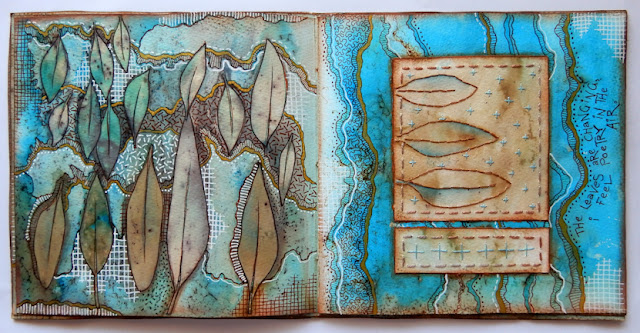Week 1: I stencilled gesso onto my page and when it was dry painted it purple and added copper highlights with metallic paste. It is a simple and fast page.
Week 2: I used coloured pencils to draw the eye on a background that had been painted then some wiped off before drying. My journal was made from old scrapbook paper that had a thin layer of gesso spread on it with a credit card. You can still see some of the printed paper through the blue paint.
Week 3: I used a die cut machine to punch butterflies out of left over scraps of painted papers. After they were glued to the page I outlined them to be more visible.
Week 4: I wanted this page to be focused on the words so I kept it simple. I used a stencil for the lettering on a previously painted paper that was glued in. I then doodled around the painted areas on the page. I did add some more paint in some areas to make them darker.
Week 5: I had this picture of a vintage lady that I wanted to use so the rest of the page is done using vintage style papers. A little brown ink around the edge of shapes makes everything look old and work together.
Week 6: This page was an experiment. I traced the sunflowers from another journal page I had drawn onto tissue paper. I then crumpled the tissue and glued it to this double page. While it was wet I sprayed on the blue and green background. When it was dry I used watercolours to paint the flowers and added the insects.
Week 8: I don't know why I didn't do week 7. This background was randomly made using a credit card to spread three colours around the page. When it was dry I could see a fox face so I added more paint to enhance the face I could see. It is all done in acrylics.
Week 9: I got some new watercolours and decided to test them out on this page. Sometimes simple and quick means you get more done.
Week 10: I wanted to try a masking technique when stencilling. You can see where I placed a circle of paper before using gesso to stencil a pattern over the whole page. When you remove the stencil the circle lifts away too and there is a smooth area to write in. The page was quickly coloured using dye sprays.
Week 11: I wanted to doodle one evening so this page was made. I used a lot of scrap papers and a few collage pictures to make the squares then doodled and wrote on all of them. I love working with grids because it is easy to make a lot of small things and then put them together to make a large piece.
Week 12: This was the last page I did for the year and the last page in this journal. I used perforated paper for the background. It is meant to be used for cross stitch and was in my stash. I wrote out the quote then added a simple border. It was coloured with standard markers.
The cover of my hand made journal has a picture that I saved from a Flavia calendar. I love her style of art.
The back cover is a collage of some torn. previously painted, paper strips. When it was dry I added the doodles.
The inside front cover was zentangled. Sometimes I just want to sit and draw or doodle. I find it relaxing.
This zentangled page is the inside back cover of the book. That was the end of this challenge for me. I still journal a lot but now I try ideas from the many art books I own. I have decided to stop looking at them and actually do the exercises from the books. It is a fun way to learn new things.



















































